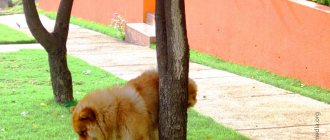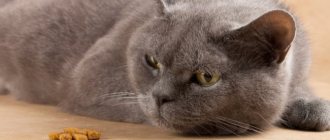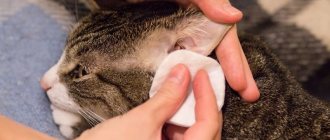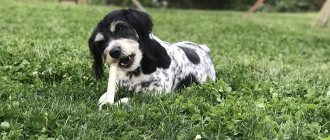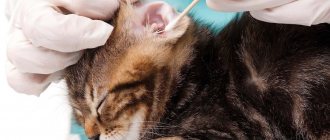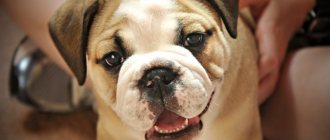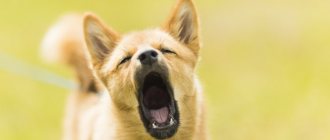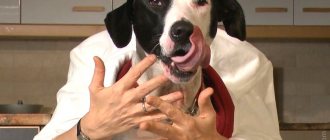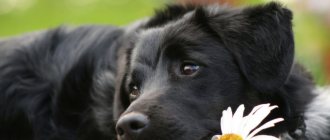Owners can easily notice some pathological changes in a pet’s body on their own – by looking at excrement. Their consistency should be soft, oblong in shape, and dark brown in color. If your dog's poop turns white, this is a serious cause for concern.
Causes of color loss
Every person, even those who don’t have a pet, has an idea of what color a dog’s feces should be. The elastic consistency and brown tint, which can vary from light to dark, reflect the good functioning of the liver and gall bladder.
When something is wrong with the animal’s organs, the feces begin to lighten, and the urine takes on a rich dark hue. External signs of stool lightening:
- loss of appetite;
- manifestation of problems with the gastrointestinal tract (diarrhea, constipation, bloating);
- nausea and vomiting, regurgitation;
- yellowing of the mucous membranes and sclera of the eyes.
The dog may show anxiety; when the first symptoms and changes in the dog’s behavior appear, observe the dog and its habits. If they change without reason, conduct a visual inspection of the animal.
Pinworms - Baby food
“Sadikov's disease” - enterobiasis?
When a child’s body is affected by worms, the mother must take care of the baby’s specific nutrition. Eating the right foods can speed up the healing process. It is worth including in the diet:
- Spicy dishes. Pepper and spicy dressings worsen the habitat for pinworms.
- Sour vegetables and fruits. In an acidic sphere, parasites die faster.
- Horseradish with mustard. Not all kids will like such a specific product. But it undermines active reproduction and temporarily paralyzes the worms.
- Walnuts, flax seeds, pumpkin seeds. Such products help destroy parasites in the intestines.
- Olive and vegetable oil. Relieves irritation of the intestinal walls.
- Dairy products. With their use, medications are better absorbed and the intestinal microflora is not disturbed.
During the period of illness, it is recommended to exclude sweets, fatty foods, and foods with a chemical composition - the consumption of harmful foods creates all the conditions for the further proliferation of pinworms in the child’s body.
"Shades" of white feces
Any change in color, the presence of inclusions, the appearance of mucus and plaque is a deviation in the functioning of the dog’s body.
The following types are distinguished according to structure and color:
- Feces covered with a white coating, or crumbly white feces - an excess in the nutrition of the bones, the possible appearance of parasites.
- Liquid white-gray or yellowish stool - improper diet, disruption of the gastrointestinal tract.
- White mucus is a disease of the large intestine or the presence of worms, an excess of connective tissue in the body (after a large consumption of stringy meat).
- Sometimes the owner can see white specks in brown stool. These could be pieces of undigested food or worms, if prevention has not been done for a long time.
Often the process of the appearance of feces is accompanied by the sounds of gases escaping from the rectum.
Ways of infection by pinworms
It is easy for a child to become infected with such a disease. He leads an active lifestyle, learning new things and playing with other children and animals. A baby can “catch” parasites in several ways:
- Oral. The child scratches the anus and parasite eggs get under the nails. Anything that the baby touches with his hands can be a site of infection.
- Bytovym. After contact with dirty toys, after eating dirty vegetables. This method is the most common. Pinworm larvae remain on the hands and, once they enter the oral cavity, they easily reach a favorable habitat.
- Contact. Favorite pets are the main breeding grounds for worms. Children love to play with them and often do not wash their hands after contact.
The most common cause is failure to maintain normal hygiene. Dirty hands, stale linen, close contact with mucous membranes have a beneficial effect on the appearance of enterobiasis. By teaching your child to be clean, you can protect him from many infections and helminth infections.
Harmless causes of light-colored stool
Very often, the reason can be harmless and will not require the owner and the dog to visit a veterinary clinic.
Causes that can be eliminated without treatment:
- Eating foods high in fat for animals - lard, fatty meat, dairy products, cheese, pork. Animal fat is poorly digestible and leads to light-colored stool.
- Constant nutrition of bones. Hard and spicy foods negatively affect the functioning of the gastrointestinal tract and liver. If bones are constantly present in your dog's food, the stool will be hard and white. After changing the diet within 3 days, the stool returns to its normal consistency and color.
- Long-term treatment with drugs that affect the liver. To treat stomach diseases or diarrhea, animals are prescribed Smecta, Augmentin and other drugs. After completing the course of treatment, it is enough to add lactobacilli to the food, which will help the liver restore its protective functions.
- Dehydration – in addition to loss of color, feces become dry.
Diagnostics
The acholic color of feces indicates that the dog needs treatment, but how and for what to treat the pet is not clear. When contacting a clinic, be prepared for the fact that the doctor will make assumptions by eye and require follow-up observation for some time. Your task is to insist on an examination, at least a laboratory one. Start with a complete blood test with liver parameters.
A stool analysis will also be very helpful; it may contain breakdown products of toxins or other suspicious “ingredients.” For a comprehensive examination, urine is also collected for analysis. Very often, increased protein or urea levels indicate problems in the diet . One of the most tragic mistakes that inexperienced owners make is choosing low-quality industrial food. It is worth understanding that cheap dry food is not healthy, moreover, it is harmful for a dog (especially a young one). Another thing to think about: low-quality food is widely advertised, but is cheap... so what are they made of? Do they contain the advertised meat and natural products or just beans, flavor enhancers, salts and chemical additives?
Diseases that cause white feces
The scientific name for white feces is acholic, translated from Greek as “without liver,” since it is the liver that is responsible for coloring feces. The main causes are liver and gall bladder diseases, the manifestation of early symptoms of which the owner did not pay attention to.
The problem of white feces is caused by:
- Gallstones are sand or stones in the gallbladder and/or its ducts. With their sharp and uneven edges, the stones injure the mucous membrane of the gallbladder, sometimes they close the ducts and cholestasis (stagnation of bile) begins.
- Malignant neoplasms - the presence of a tumor of an oncological nature causes disruption in the functioning of the entire body, and first of all, the outflow of bile stops.
- Cholecystitis (Cholangitis) is inflammation of the gallbladder and ducts. The dog is vomiting with a large amount of mucus. Vomit contains bile, which irritates the gastric mucosa and leads to flatulence, diarrhea and bloating. The animal becomes lethargic, moves apathetically, and fever often sets in. Due to pain inside the abdominal cavity, she often lies on her stomach, arching her back.
- Liver cirrhosis is an intensive and irreversible replacement of healthy cells by fibrous tissue.
- Hepatitis is an inflammation of liver tissue. Appears along with diseases of the stomach and pancreas. In the body, protein, carbohydrate-fat and pigment metabolism is disrupted, and organ cells disintegrate. The dog's temperature rises.
- Cholangiohepatitis is inflammation of the liver and ducts at the same time.
- Cysts are the appearance of operable benign formations that impede the normal functioning of the organ.
- Deformation of the bile ducts is a change in the normal shape or size of the gallbladder, adhesions. The disease is congenital or acquired.
- Pancreatitis is inflammation of the pancreas.
Prevention of pathologies
Let us remind you once again that white stool in a dog can indicate a dangerous disease - liver cancer. It is important to monitor what your pet eats. His body must receive enough calcium, magnesium, and vitamins. The dog must undergo an examination every six months. Preventive examination allows you to detect diseases in time. And timely treatment is the key to successful recovery! Treatment against ticks should be carried out; if necessary, get vaccinated.
In addition, many breeders believe that the appearance of white feces is due to poor nutrition. A dog should not chew bones, especially spoiled ones. This actually leads to liver pathologies. If an animal does not eat properly, the liver accumulates toxins. It is worth saying that bones are food waste, and the liver reacts poorly to them. If you are trying to save money on feeding your pet, you can give him porridge with boiled offal. Don't give your dog bones: take care of his health.
Currently reading:
- Thyroid dysfunction in dogs (hypothyroidism)
- Five reasons why dogs eat their own and other people's feces
- How to recognize signs of dog poisoning from rat poisons
- Causes of kidney stones in dogs and methods of treatment
Owner behavior - prompt assistance
If you see white feces on your dog for the first time, there is no need to panic. Analyze all the reasons for its appearance and observe the animal for 2-3 days. If your dog's stool does not change and his behavior becomes alarming, consult a doctor.
Before prescribing treatment, the veterinarian will ask the animal to conduct the following tests:
- urine and blood to identify inflammatory processes and the condition of the liver; in difficult cases, instead of a general study, a biochemical study will be performed;
- stool and biochemical urine analysis to determine the condition of the pancreas;
- if neoplasms are suspected, ultrasound of the abdominal cavity;
- X-ray of the liver or in some cases a biopsy.
Based on research results, doctors prescribe treatment in several areas:
- Antibiotic therapy (Trichopol, Cephalexin).
- Choleretic (Allohol, Holosas).
- Hepatoprotectors (Hepatoject, Hepatovet).
- Antispasmodics and analgesics (No-Shpa, Baralgin, Butofanol).
- Enzymes (Mezim, Creon).
If the presence of a cyst or cancerous tumor in an animal’s body is confirmed, surgery is always performed.
Solution
After diagnosis, the problem is eliminated by treating the found disease with medications or surgery. It is equally important to review the existing diet in order to reduce the load on the affected organs.
Treatment of diseases
Surgical intervention is used only in the most severe cases: gallstone disease and neoplasms. If the stones in the gallbladder are represented by sand, then it is removed with the help of special medications and a therapeutic diet.
It is also worth refusing surgery if there are metastases. Excision of the tumor in such cases carries many risks, so surgery is unjustified.
Inflammatory diseases are treated at home with the following medications:
- antibiotics (Trichopol, Trimethoprim, Cephalexin) that fight bacterial infections;
- choleretic (Allohol, Ursosan, Holosas), increasing the production of bile;
- antispasmodics (No-shpa, Baralgin, Papaverine), which relieve pain;
- hepatoprotectors (Covertal, Thiotriazolin, Hepatovet), restoring liver cells;
- enzymatic (Mezim, Creon), normalizing the natural microflora in the gastrointestinal tract.
Before recovery, you will have to undergo several tests to ensure the effectiveness of the therapy. Pets with growths that cannot be removed will need to visit the veterinarian regularly even after the condition improves.
Diet adjustments
When feeding naturally, fatty fermented milk products, smoked meats, lard, bones, pasta, as well as fruits and vegetables without heat treatment should be excluded from the diet. The new diet should consist of:
- boiled lean meat (chicken, turkey);
- boiled vegetables (zucchini, carrots);
- light meat and fish broths;
- watery cereals (buckwheat, oatmeal);
- fermented milk products (cottage cheese, yogurt, kefir) with low fat content.
If the animal eats dry food, then preference should be given to a medicinal line recommended for digestive problems, at least premium class. Cheap economy-class food should be avoided: they contain a lot of salts and sugars, and their nutritional value is not enough for proper nutrition.
Feeding should be fractional. Food is given 5-6 times a day in small portions. This supply eliminates the feeling of hunger, which is typical for too long breaks, and reduces the load on the gastrointestinal tract. Additionally, it is recommended to drink a decoction of chamomile. It has an antibacterial effect and cleanses the liver and gallbladder of toxins.
What are the symptoms of constipation in dogs?
The main symptoms include:
- bloated stomach;
- frequent gas;
- attempts to defecate without passing stool;
- dry feces that comes out in small quantities;
- poor appetite or lack thereof;
- general lethargy and inactivity.
During constipation, the animal feels very strong discomfort, which is often accompanied by abdominal pain and pain when trying to go to the toilet. The absence of feces during the urge to defecate or the release of dry feces brings a lot of pain to the pet, sometimes the animal may whine or howl.
Feces stagnate in the dog's intestines due to the lack of fluid: the intestinal walls draw water from the feces, as a result of which they become dry and thickened. They literally clog the intestines.
